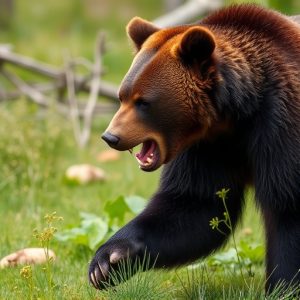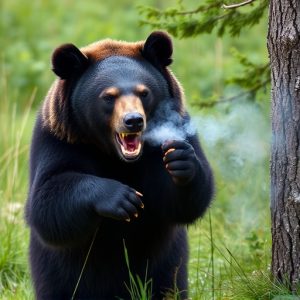GrizGuard Bear Spray Training: When, How, and Aftercare Techniques
Bear spray is a crucial tool for safety in bear country, with two main types: oleoresin capsicum (OC…….
Bear spray is a crucial tool for safety in bear country, with two main types: oleoresin capsicum (OC) and alpha-cyanoacrylate (ACA). Proper usage involves aiming at the bear's eyes and face during close encounters. Timing and technique are vital; correct deployment can prevent aggression and provide escape time, though it's not 100% guaranteed. Use bear spray proactively in peak seasons or when unexpectedly close to a bear displaying defensive behaviors. Aim for a range of 10-25 feet with quick, short bursts to temporarily disrupt the bear's senses. Follow post-exposure protocols, aiming for the bear's eyes and face as a last resort. Regular training enhances safety in bear country.
“GrizGuard bear spray safety training equips outdoor enthusiasts with crucial knowledge on when and how to use bear spray effectively. This comprehensive guide delves into the intricacies of understanding bear spray types, their effectiveness, and situational awareness—crucial elements in navigating wild environments. We explore optimal application techniques to ensure maximum protection, as well as post-exposure protocols for care and prevention. Learn the art of using bear spray properly, enhancing your safety in unexpected encounters.”
- Understanding Bear Spray: Types and Effectiveness
- Situational Awareness: When is Bear Spray Necessary?
- Application Techniques: Ensuring Maximum Protection
- Post-Exposure Protocols: Care and Prevention After Use
Understanding Bear Spray: Types and Effectiveness
Bear spray, also known as bear deterrent spray, is a crucial tool for individuals venturing into bear country. Understanding its types and effectiveness is essential for safety in situations where bears are present. There are primarily two types of bear spray on the market: oleoresin capsicum (OC) and alpha-cyanoacrylate (ACA). OC sprays are more common and utilize capsaicin, the active ingredient found in chili peppers, to cause a burning sensation in the eyes and nose of the target animal. ACA sprays, while less common, adhere to the bear’s fur, creating a barrier that disrupts their sense of smell, disorienting them.
The effectiveness of bear spray depends on several factors, including when it is used properly. It is most effective as a deterrent during close encounters with bears, when sprayed directly into the animal’s face. Timing and technique are key; users should aim for the bear’s eyes and nose, creating a large enough cloud to ensure both immediate and long-term irritation. Proper use can prevent aggressive behavior and provide valuable time for escape or retreat. It’s important to remember that no bear spray is 100% guaranteed, especially against defensive or surprised bears, but understanding when and how to deploy it properly can significantly enhance safety in potential encounters.
Situational Awareness: When is Bear Spray Necessary?
Bear spray, also known as urushiol-based repellents, is a valuable tool for individuals venturing into bear country. However, understanding when to use it properly is crucial for ensuring safety and effectiveness. Situational awareness plays a pivotal role in this decision. Bear spray is not just for direct encounters but can be a necessary precaution in various scenarios.
One should consider its use when hiking or camping in areas known for bear activity, especially during peak seasons. If you find yourself unexpectedly close to a bear, or it displays defensive behaviors like huffing, snorting, or clacking its teeth, deploying bear spray can create a barrier of protection. Proper usage involves aiming at the bear’s face and eyes from a safe distance, temporarily disabling it and providing an escape route for humans.
Application Techniques: Ensuring Maximum Protection
When it comes to bear spray safety, understanding application techniques is paramount. To ensure maximum protection, it’s crucial to know when to use bear spray properly. The ideal scenario is when you encounter a grizzly bear at close range, typically within 10-25 feet. At this distance, aim for the bear’s face and eyes, spraying from a safe distance to create a barrier without risking direct contact.
Proper application involves using quick, short bursts of spray. This technique helps distribute the irritant effectively while minimizing your exposure. Remember, bear spray is designed to disrupt a bear’s senses temporarily, giving you time to retreat. Inadequate or inconsistent spraying might result in the bear not being affected, leaving you vulnerable and potentially requiring additional measures for self-defense.
Post-Exposure Protocols: Care and Prevention After Use
After using bear spray, it’s crucial to follow specific post-exposure protocols for proper care and prevention. If a bear encounter occurs, users should ensure they have left the immediate area and are at a safe distance before evaluating any injuries or symptoms. Bear spray can cause irritation, so immediate thorough washing of skin and clothing with soap and water is essential. Any contaminated gear should be thoroughly cleaned to prevent further exposure.
For potential future encounters, it’s important to remember when and how to use bear spray properly. Users should aim for the eyes and face of the bear, creating a barrier between themselves and the animal. Only use bear spray as a last resort when an attack is imminent; spraying unnecessarily can agitate bears further. Regular training sessions with GrizGuard bear spray can help individuals recognize appropriate usage scenarios, enhancing their safety in bear country.
Bear spray is a valuable tool for personal safety in bear country, but its effective use depends on understanding when and how to deploy it. By enhancing situational awareness and learning proper application techniques, individuals can maximize the protection offered by bear spray. Always follow post-exposure protocols to ensure care and prevent further risks after use. Remember, knowing when to use bear spray properly can make a significant difference in potentially dangerous encounters with bears.


